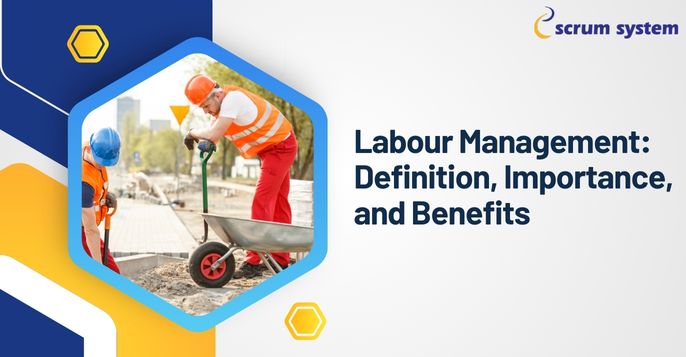Effective labour management is inevitable for any organisation to find combined employees’ productivity, job satisfaction, and increased performance for winding up successful business ventures. It helps in making sure that the workforce is efficiently coordinated, resources are used, and the right task is put in place. Definition, importance, and the various benefits of labour management are discussed in his blog. This blog explains modern labour management and its various important tools and systems such as Contract Labour Management Systems and Software.
Appreciating Labour Management
Labour management may be described broadly as the means by which an organisation structures its workforce associated processes and practices. It comprises a wide range, from hiring to training, scheduling, monitoring performance, and ensuring compliance to labour laws. It most importantly works on the optimization of the productivity and efficiency of the employees by maintaining the work environment in a positive manner.
Effective labour management encompasses taking care of daily running of workforce operations, through strategic planning such that the workforce emerges relevant to long-term organisational goals. It includes workforce planning, talent development, and succession planning. Tackling immediate needs along with potential future growth allows such a flexible and strong workforce to be created.
The Importance of a Labour Management System
A labour management system is a centralised tool devised for controlling and automating a range of functions involved in labour management. It is a centralised platform for keeping track of employee information, scheduling, and performance monitoring. There are a number of key benefits to implementing a labour management system:
Efficiency and Productivity: A labour management system entails good scheduling, meaning the correct number of workers is recorded working at the correct time. This minimises downtime and increases productivity. Automated scheduling really ensures that the managerial team does not spend a lot of time on administration, hence allowing them to do much that is strategic.
Precise Time Tracking: Manual tracking of time often has numerous errors and is generally not accurate. Labour management systems automate this process to provide pinpoint accuracy in tracking working hours, overtime, and leave. It not only increases the accuracy of the payroll but also guarantees compliance with the laws on labour.
Better Communication: Smooth operations can be performed through good communication. A labour management system creates easy communication between managers and employees to quickly get the message spread—related to significant or top-priority information, schedule changes, and updates—allowing a work environment to be collaboration-based, with very low chances of any misunderstandings.
Data-Driven Decision Making: Real-time data provided by a labour management system is the impetus for effective decision making done by a manager on effective planning. Information on workforce performance and patterns of rate of attrition and productivity will help identify areas for improvement and clock strategies that work.
A contract labour management system is designed to manage extra contracts or temporary manpower in real-time. These systems are very vital and important for any company whose workforce is flexible, easily and efficiently adjusted to regular changes and/or frequent fluctuations. A contract labour management system offers some unique advantages.
Easier Onboarding: Contract employees often have to be onboarded fairly quickly to begin contributing effectively. Automation in the process of contract labour management makes onboarding easier with paperless processes for paperwork, compliance checks, and training modules. This, in turn, ensures that the contract workforce remains productive from day one.
Compliance and risk management: Managing contract workers need to comply with many legal and statutory requirements. A system of management of contract labour helps in maintaining this type of compliance, whether it is a labour act, safety regulation, or the terms of the contract on the whole. In this way, the legal risk is minimised, and all the associated documentation is in place.
Cost Control: The manpower under contract labour is usually taken aboard for managing the fluctuations of workload. Therefore, a management-related contract labour management system helps greatly to provide in-depth insights into labour cost for enabling proper budgets and expense controls by the organisation. Companies can optimise labour costs based on contract duration information, billing rates, and hours actually worked.
Performance Monitoring: Continuously monitoring the performance of the contract workers guarantees that standards set are maintained. The labour administration system assists the managers in monitoring performance metrics, level of productivity, and in providing feedback appropriately. This is going to make them contract workers be part of the contribution towards the success of the organisation.
Contract Labor Management Software Benefits
Contract Labour Management Software is, in essence, the superstructure of the same software of the previously mentioned kind, providing features that are way more enhanced and ameliorated. This software is meant to handle the complexities of managing a contract workforce in a way that would be seamless and efficient:
Existing System Integration: Contract labour management software can be easily integrated with existing HR and payroll systems, allowing organisations to have one central platform for both permanent and contract workforce management. This integration eliminates data silos, reduces duplication of efforts, and ensures that information is consistent across the organisation.
Automated workflows are one of the most central features of any contract labour management software. These enable automatic approvals of timesheets, certified expense claims, and processes for contract renewals, among other things. This would save time for managers, assure the conducting of processes in due time, therefore lessening the instances of errors.
Improved Reporting and Analytics: Advanced reporting and analytics are a must-have within the contract labour management software. This helps in creating reports related to labour costs, contract durations, and workforce performance in fine detail and fosters greater decision making and strategic planning.
Scalability: An organisation’s hiring strategy and workforce needs change with the growth of the organisation. An organisation is able to handle more numbers of contract workers with no loss in the efficacy in handling such cases. This quality of Scalable Contract Labour Management software, therefore, gives the assurance of adaptation to the changing business requirement.
User Interface: It is quite user-friendly as, nowadays, contract labour management software comes with user-friendly dashboards, self-service portals, and accessibility via mobile phones.
Other Benefits of Effective Labor Management
The adoption of an effective labour management system, either for full-time employees or contract workers, has various benefits and ensures organisational growth and success.
Improved Workforce Productivity: An effective labour management system would lead to optimization of effective schedules, improved tracking of performance, and assurance that the right number of personnel is available. Employees work effectively with no interludes of breaks in their duty; hence, they provide powerful work output and increase productivity.
Reduced Labour Costs: Proper labour management helps in controlling the cost of labour by reducing overtime, minimising absenteeism, and using the labour resources effectively. Automated time tracking and its management for the workforce guarantee its right usage and assist in saving costs otherwise lost on errors and fallible knocks of time.
Benefits in More Employee Satisfaction: An effectively managed workforce takes measures on how it satisfies workers. If the scheduling is done properly and payments are made at the right time, this boosts morale, and perfect labour management is achieved with zero-turnover rates.
Complying and Minimising Risks: Compliance with labour laws and regulations is the way to follow in order to keep off litigation and penalties. Good labour management covers the aspect of compliance to any requirement, thus reducing the risk of litigation and keeping the reputation of the entity intact.
Strategic Workforce Planning: Labour management systems help an organisation understand the trends in its workforce and performance metrics, enabling the designing of adequate planning based on future needs, developing associated skill gaps, and talent strategies. Strategic workforce planning guarantees an organisation’s readiness, which simply means that the organization can meet its goals and becomes properly equipped to address the change in market situations.
Conclusion
Effective labour management ensures optimised productivity from the workforce, cost reduction, and compliance. Managing the contracted staff the same way one manages permanent employees, a robust labour management system featuring CM software, handles the tasks at hand with great efficiency, thus upping productivity and enabling better decision-making from the insights gained in the real-time management of the workforce.
For the best labour management system, Scrum System is the story to go by. The numerous features, the simplified interface, and advanced capabilities say Scrum System is a one-stop solution for permanent and contracted workforces. Whether you need to streamline scheduling, track performance, or ensure compliance, Scrum System has you covered.
Investing with Scrum System for your labour management requirements is not just the key to efficiency and productivity but also to your commitment to innovation and excellence. Herein lies the future of labour management: Scrum with experience.



